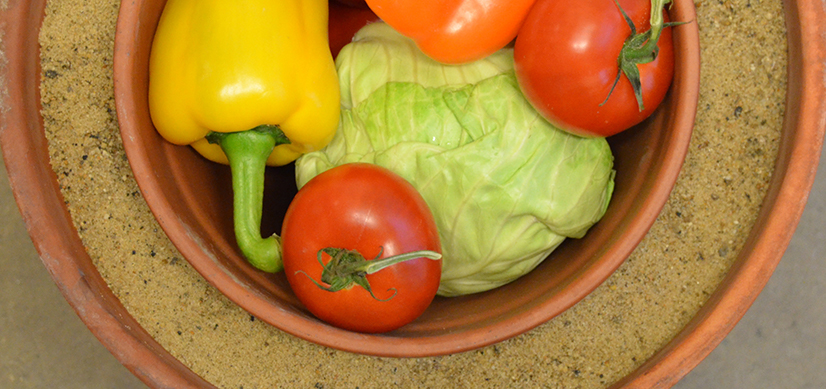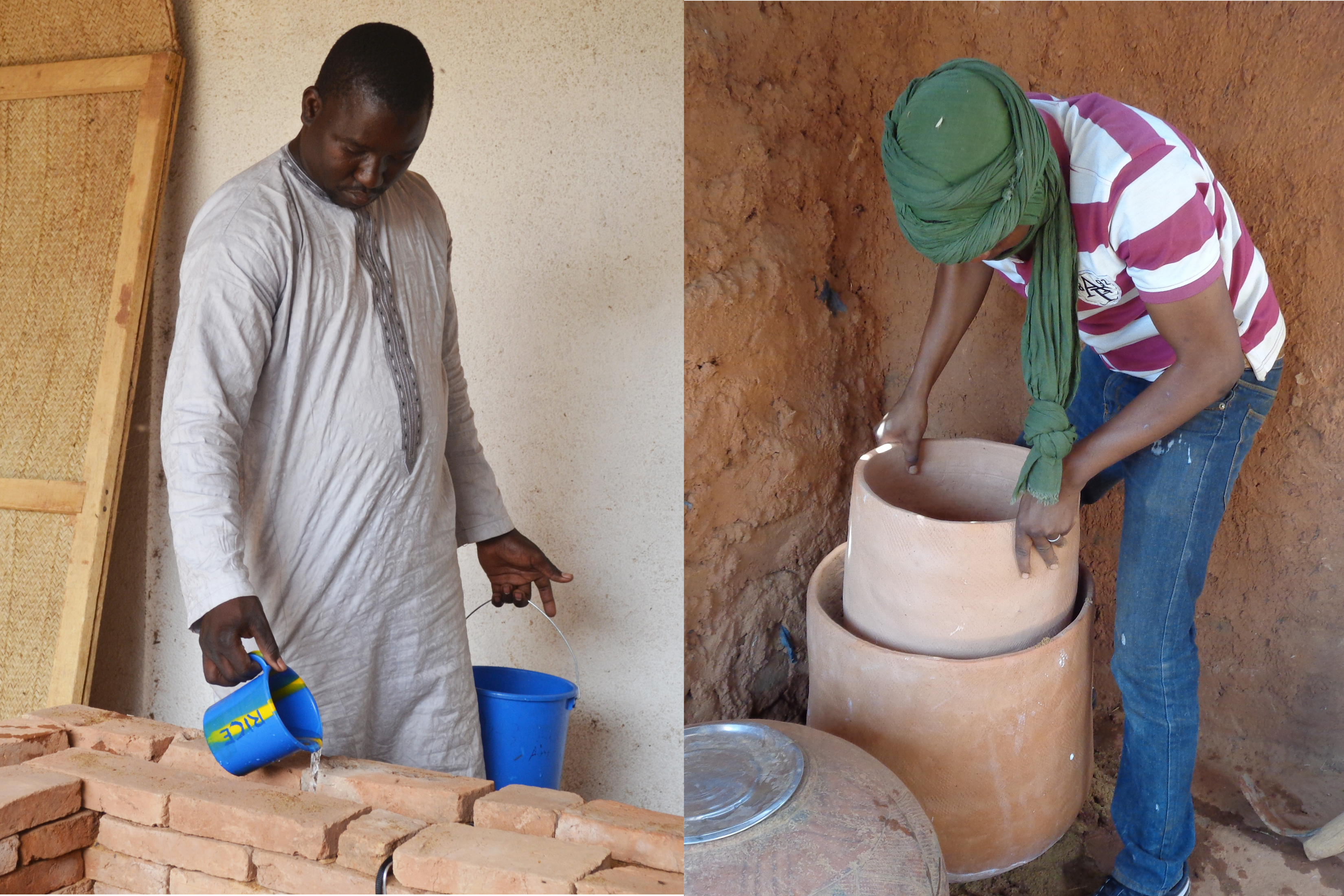
CITE and D-Lab study finds evaporative cooling devices show promise for helping small-scale farmers, market vendors, and families store and preserve vegetables.
Across the Sahel, a semiarid region of western and north-central Africa extending from Senegal to Sudan, many small-scale farmers, market vendors, and families lack an affordable and effective solution for storing and preserving vegetables. As a result, harvested vegetables are at risk of spoiling before they can be sold or eaten.
That means loss of income for farmers and vendors, reduced availability of nutritious foods for local communities, and an increase in the time spent traveling to purchase fresh produce. The problem is particularly acute in off-grid areas, and for anyone facing financial or technical barriers to refrigeration.
Yet, as described in a recently released report “Evaporative Cooling Technologies for Improved Vegetable Storage in Mali” from MIT’s Comprehensive Initiative on Technology Evaluation (CITE) and MIT D-Lab, there are low-cost, low-tech solutions for communities in need of produce refrigeration that rely on an age-old method exploiting the air-cooling properties of water evaporation. Made from simple materials such as bricks or clay pots, burlap sack or straw, these devices have the potential to address many of the challenges that face rural households and farmers in need of improved post-harvest vegetable storage.
The study was undertaken by a team of researchers led by Eric Verploegen of the D-Lab and Ousmane Sanogo and Takemore Chagomoka from the World Vegetable Center, which is engaged in ongoing work with horticulture cooperatives and farmers in Mali. To gain insight into evaporative cooling device use and preferences, the team conducted interviews in Mali with users of the cooling and storage systems and with stakeholders along the vegetable supply chain. They also deployed sensors to monitor product performance parameters.
A great idea in need of a spotlight
Despite the potential for evaporative cooling technologies to fill a critical technological need, scant consumer information is available about the range of solutions available.
“Evaporative cooling devices for improved vegetable storage have been around for centuries, and we want to provide the kind of information about these technologies that will help consumers decide which products are right for them given their local climate and specific needs,” says Verploegen, the evaluation lead.
The simple chambers cool vegetables through the evaporation of water, in the same way that the evaporation of perspiration cools the human body. When water (or perspiration) evaporates, it takes the heat with it. And in less humid climates like Mali, where it is hot and dry, technologies that take advantage of this cooling process show promise for effectively preserving vegetables.
The team studied two different categories of vegetable cooling technologies: large-scale vegetable cooling chambers constructed from brick, straw, and sack suitable for farming cooperatives, and devices made from clay pots for individuals and small-scale farmers. Over time, they monitored changes in temperature and humidity inside the devices to understand when they were most effective.
“As predicted,” says Verploegen, “the real-world performance of these technologies was stronger in the dry season. We knew this was true in a lab-testing environment, but we now have data that documents that a drop in temperature of greater than 8 degrees Celsius can be achieved in a real-world usage scenario.”
The decrease of temperature, along with the increased humidity and protection from pests provided by the devices, resulted in significant increases in shelf life for commonly stored vegetables including tomatoes, cucumbers, eggplant, cabbage, and hot peppers.

“The large-scale vegetable cooling devices made of brick performed significantly better than those made out of straw or sacks, both from a technical performance perspective and also from an ease-of-use perspective,” notes Verploegen. “For the small-scale devices, we found fairly similar performance across differing designs, indicating that the design constraints are not very rigid; if the basic principles of evaporative cooling are applied, a reasonably effective device can be made using locally available materials. This is an exciting result. It means that to scale use of this process for keeping vegetables fresh, we are able to look at ways to disseminate information and designs rather than developing and distributing physical products.”
The research results indicate that evaporative cooling devices would provide great benefit to small-scale farmers, vendors selling vegetables in a market, and individual consumers, who due to financial or energy constraints, don’t have other options. However, evaporative cooling devices are not appropriate for all settings: they are best suited to communities where there is access to water and vegetable storage is needed during hot and dry weather. And, users must be committed to tending the devices. Sensor data used in the study revealed that users were more inclined to water the cooling devices in the dry season and reduce their usage of the devices as the rainy season started.
Resources for development researchers and practitioners
In addition to the evaluation report, Verploegen has developed two practitioner resources, the “Evaporative Cooling Decision Making Tool” (which is interactive) and the “Evaporative Cooling Best Practices Guide,” to support the determination of evaporative cooler suitability and facilitate the devices’ proper construction and use. The intended audience for these resources includes government agencies, nongovernmental organizations, civil society organizations, and businesses that could produce, distribute, and/or promote these technologies.
Both resources are available online.
As part of an ongoing project, MIT D-Lab and the World Vegetable Center are using the results of this research to test various approaches to increase dissemination of these technologies in the communities that can most benefit from them.
“This study provided us with the evidence that convinced us to use only the efficient types of vegetable cooling technologies — the larger brick chambers,” says World Vegetable Center plant health scientist Wubetu Bihon Legesse. “And, the decision support tool helped us evaluate the suitability of evaporative cooling systems before installing them.”
Launched at MIT in 2012, CITE is a pioneering program dedicated to developing methods for product evaluation in global development. Currently based at MIT D-Lab, CITE’s research is funded by the USAID U.S. Global Development Lab. CITE is led by Professor Dan Frey of the Department of Mechanical Engineering and MIT D-Lab, and additionally supported by MIT faculty and staff from the Priscilla King Gray Public Service Center, the Sociotechnical Systems Research Center, the Center for Transportation and Logistics, the School of Engineering, and the Sloan School of Management.

